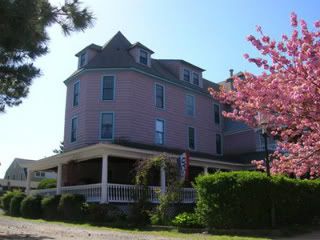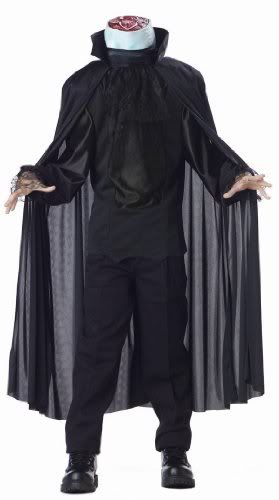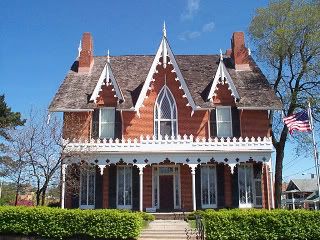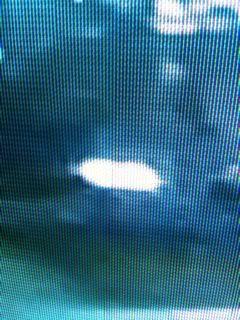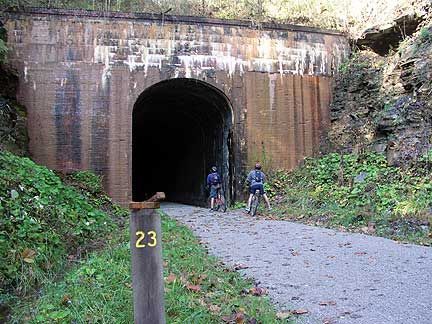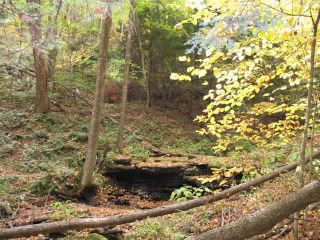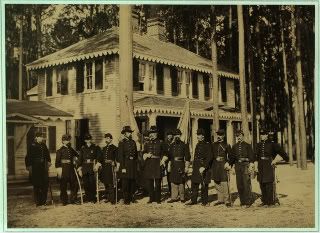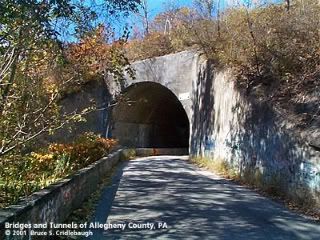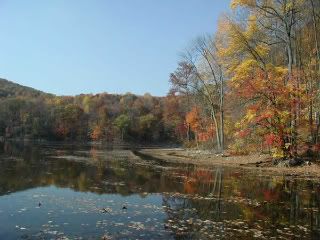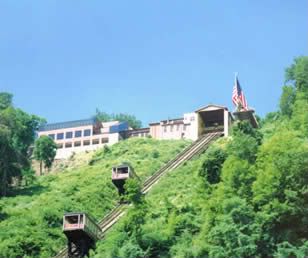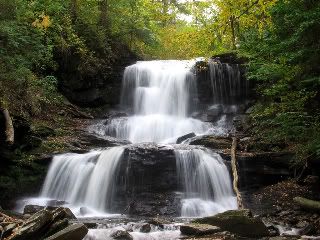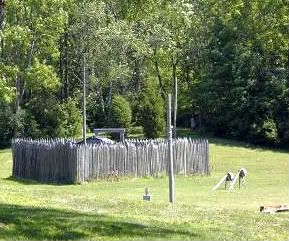Old Kenyon
Bishop Philander Chase established Kenyon College on a hilltop overlooking central Ohio's Kokosing River Valley in 1825. The first permanent building, Old Kenyon, went up a couple of years later. The Gambier, Knox County institution has evolved into a highly regarded liberal arts school.
But hey, with almost two centuries of existence, you know the school has more attached to it than a long list of distinguished alums (which it most certainly boasts). It's considered one of the more heavily haunted sites in the state. It starts when you enter the campus.
The southern campus gates on the school's Main Path are said to have been built over a Hellmouth, or portal to Lucifer's lair. One shouldn't walk between the pillars when the bells in the Church of the Holy Spirit are chiming at midnight, unless looking for a one-way ticket to perdition. That's why they're known by the students as the "Gates of Hell."
Others warn to never look into the trees shading the gravelly Middle Path. Because of their shape, they're considered "pitchfork trees." We're not exactly sure what that means, but it sounds sufficiently sinister enough that we sure as heck don't plan to find out. Superstitious Kenyon students who pass between the old gates always tap one as they pass, apparently to keep themselves grounded in the material world.
Once you're safely on campus, there's hardly a building that doesn't have a tale connected with it.
Bailey House: There are reports of footsteps in an empty building, cold spots and a sense of presence.
Caples Hall: The ghost of a student who died in a plunge down an elevator shaft allegedly still holds a grudge against girls in Caples Hall. The most popular story is that the guy, returning unexpectedly from a party, found his girl with another fella. This led to a pretty nasty argument, and she barricaded her door with a bureau while the angry beau either fell or was pushed down the shaft, presumably by the other guy.
(Another version has the guy staying overnight with his girlfriend, and when groggily leaving in the morning, stepped through the elevator doors without noticing that there was no elevator car and fell to his death. We like the first tale better; it explains the spooks' campaign against females.)
The gal involved later felt icy hands covering her face as she slept and found her door blocked by her dresser on different occasions. The jilted lover's transparent spook has been reportedly seen leaning against female students' furniture, and sometimes pushes dressers against dorm room doors in a ghostly reenactment of his last night on this mortal coil. The spirit actually tries to physically harm females in the hall, according to the lore, accused once of smothering a girl with her pillow.
The events all take place on the eighth floor.This is supposedly based on an actual incident that happened at Caple, although we suspect the details have become fairly well muddled over time.
Church of the Holy Spirit: The 19th century chapel is thought to be cursed. There are scorch marks by the windows (although no record of a fire exists) but they run down instead of up, meaning the flame that caused them burnt downwards. That defies physics, but it is the right direction if you're headed to Hades. It seems fitting. The church is alleged to sit over the pits of Hell, yet another gateway to Old Scratch's realm.
There are also reports of a priest's ghost, a pitch-black shape seen under the choir loft. Years ago, the father was said to have gone loco and locked himself in the office of the Church. The legend is that he hung himself in the belltower and is now condemned to haunt the church forever as his eternal punishment.
The DKE Pledge: In 1905 Stuart Pierson was killed while pledging the DKEs when he was struck by a train on a trestle over the Kokosing River during his initiation. Every year on the accident's anniversary date of October 28th, Stu's ghost is said to gaze forlornly out of a window as the trains pass. In fact, whoever's living his former room in Old Kenyon vacates it that day for Stuart to reclaim.
Pierson's shadow now has to watch Schwinns whizzing by instead of locomotives as his fateful railroad line has been replaced by a bike trail. Stuart is active during the rest of the year, too. He opens and closes windows on the top floor and his footsteps can be heard treading across the roof through the ceiling.
Those with a more skeptical bend suspect that the Stu story is just a way for the DKE brothers to spook the pledges. They hold a ceremony with a processional carrying a coffin to the trestle, followed by various readings while dressed in frat regalia on the anniversary of "Stewie's" death. Nothing like a little pomp and circumstance.
One positive came from Stu's untimely demise, which is a documented event. For the first time, the Greek community began to examine the question of fraternity hazing, although it would take decades to finally tone down the practice.
The Hill Theater: It's located inside the Shaffer Speech Center, which was supposedly built on site of a drunk driving accident that killed two students. Night staff routinely find the ghost light (a theatrical night light) unscrewed on the Hill stage. Although they turn it back on and lock the building, they often find it unscrewed again on their next visit. The stage curtains are also often found mysteriously open after having been closed following the evening rehearsals.
Guards have also allegedly reported seeing the spirit of a student who fell to his death from the catwalk. The sound of his body repeatedly thumping against the backstage is said to echo through the theater.
Kokosing (Bishop's) House: The Kokosing House, also known as the Bishop's House, was built in 1864 by Bishop Gregory Thurston Bedell. Residents and guests have reported organ music, doors which had been closed standing open, strange noises in the front room, creaking floors, footsteps and banging windows. The resident ghost, a female, has been seen on the house balcony and stairwell, although nobody is quite sure who she is.
Leonard Hall: Room thirteen (where else?) is supposedly haunted. Residents report creaking sounds and a sense a presence. A guard once claimed to have seen a figure in a ball cap that disappeared in front of him.
Lewis Hall: A freshman who hanged himself in the attic (which has since been boarded up) turns lights on and off, randomly flushes toilets, and disturbs students by knocking on their doors. Kinda hard to tell the difference between a flesh-and-blood frosh from a spook, judging by that phenomena.
Manning Hall: A student who died of leukemia before she could attend classes keeps herself busy waiting for her first day of courses to arrive. She rearranges furniture and student belongings in her old dorm room, 108, as if still preparing herself for the upcoming school year.
Mather Hall: The basement of this dorm is supposed to have trap doors that lead down to the Gateway to Hell (the third one on campus, by our count). It's said that if they're opened a Satanic altar will appear along with a flaming stairway leading to Satan's sin bin.
Norton Hall: A student who committed suicide in his dorm room roams the hall's corridors. The female spirit is said to be a night stalker of sorts. She noisily paces the dorm late at night when most of the living students are asleep, or at least trying to sleep. Why? Because she was an insomniac in real life who walked the halls when she couldn't sleep.
Old Kenyon: On February 27th, 1949, nine students were killed in a blaze that consumed the school's oldest building, dating to 1827. It was rebuilt the following year, and tales of the victim's spirits began almost immediately after it reopened. The shadows of the unfortunate nine were reported gliding down the halls, visible only from the knees up because the foundation of the new dorm was higher than the one of the former building. Some students claimed to see the transparent legs of the ghosts hanging through the ceiling of a lower floor.
More eerily, night cries of "Get me out of here!" are heard, along with "Wake up, fire!" ringing through the halls, accompanied by the violent shaking of closed doors. It's also been said that 1949 yearbooks are sometimes found open to the page with the names of the nine victims.
There's also a little contrarian history involved. Some claim that the ghosts are actually nine women who died in the fire while staying over at Old Kenyon with their boyfriends after a Sophomore dance. The school administration never conceded the possibility that girls were in the all-male dorm. But it's said that at night you can hear a group of women singing around Old Kenyon.
Rosse Hall: There's a portrait of Lady Rosse, a supporter of Bishop Chase, in the hall foyer ("Lady Jane King"). It's said the picture's eyes will follow you around, and if you stare at the portrait too long, you'll be cursed.
Shaffer Pool/Bolton Dance Studio: This building used to be the home of the Kenyon swimming pool. According to legend, a swimmer using the high dive board bounced his head off the glass ceiling (the original pool was called "The Greenhouse" because of that feature), broke his neck, splashed into the pool and drowned.
There is no record of that sort of event ever happening, but there sure are a lot of spooky tales that make it seem possible. When the old pool was still used (it's since moved to a modern athletic complex), swimmers sometimes heard a voice calling out for help or lifeguards would hear someone thrashing in the water, only to find the pool empty. Conversational voices have been heard, too.
The Dance Studio has been plagued by the unexplained as well. Wet footprints lead into the old locker room area or to walls where they dead end. Splashing and springboard sounds are heard by dancers in the studio, and a small white face with wet, slicked back hair has been reported peeking out through a window at passersby.
A school tradition has the old pool, which was located in the current Shaffer basement (it's now a boiler room) visited annually by the swim team before their championship meet. By candlelight, the team goes down the spiral staircase and gathers around one of the seniors, who tells the story of "The Greenhouse Ghost" to get the squad in the mood to do-or-die in the upcoming meet.
It's been said that the ghost moved to the new pool, though that's unconfirmed. That's a lot of spectral swimming for our water wraith.
Wertheimer Fieldhouse: A jogging ghost has been reported by the night guards, unseen but heard running around the track. There are also claims of music coming from the storage area, apparently as the track spook winds down after his workout. The spirit may not even have a Kenyon connection. The fieldhouse was part of an old off-site Navy installation and was donated to the college. It was transported to Kenyon, so maybe the jogger came along for the ride.
With all these tales, we still probably haven't done justice to Kenyon's haunted history. Tim Shutt, a professor well known for his ghost tours, which he conducts in a top hat and waistcoat, is the man to find when you're on campus. He knows where all the skeletons are hidden.








